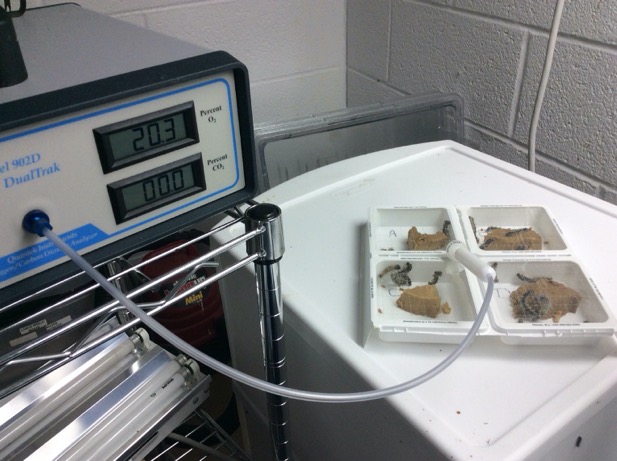This important topic is too often neglected in dealing with quality, fitness, and stress in insect rearing systems. I discuss this in depth in my rearing courses, and I provide here a sample of what I discuss.
First, it is important to realize that for nearly all metabolic functions, insects utilise oxygen and release carbon dioxide as a waste. the normal atmospheric O2 level is slightly under 21%, and the CO2 content is about 0.04% (often stated as 400 parts per million). In nature, insects generally have access to the normal levels of O2 and CO2, which raises the question of what levels of these gases are present in our rearing containers? Another important question is what are the consequences of abnormal levels of these gases? To begin to answer the first question, I used an O2 and CO2 measuring apparatus (see picture below) to determine the levels of these gases in a container where I was rearing painted lady butterfly larvae (Vanessa cardui).


Figures 1 and 2 show measurements of rearing containers for painted lady larvae. In the containers in Figure 1, we found the O2 content to be 19.4% and the CO2 content to be 0.4% (roughly 10 times normal atmospheric CO2). These readings indicate that even in non-crowded rearing conditions seen here, there is an indication that the insects may be chronically in an oxygen-depleted atmosphere (a hypoxic situation) and also in a chronically elevated CO2 atmosphere. This raises the question about what the possible effects are from this chronic “gas exchange stress.”
One hint as to the effects of this stress is to be derived from a recent paper by VandenBrooks et al. 2018, where the authors show that in Drosophila melanogaster, there are significant changes in the characteristics of the gas exchange system of D. melanogaster, the tracheoles, and the respiratory organelles, the mitochondria.

The implications of these findings are of potential great consequence in shaping the fitness of insects from our rearing systems where the conditions are often crowded and of untested atmospheres inside rearing containers.
This type of discussion is typical of what Professor Cohen covers in the current set of rearing courses. The potential for stress from all these parameters is ever-present: thermal, gas exchange, humidity, lighting, diet, microbes, and countless other conditions.
